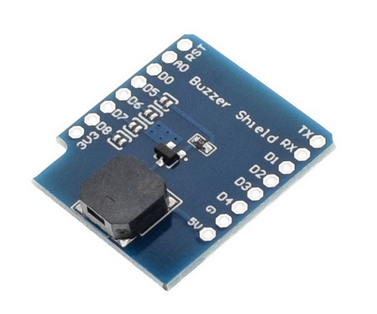The Buzzer shield
The Hardware
The buzzer shield implements a passive buzzer with frequencies up to 1 kHz - 3 kHz. By default it uses data line D5 corresponding to GPIO 14 but can be configured to a different GPIO line. In order to make the device work a solder bridge for the data line must be installed ( see the 4 double solder blobs on the left hand side of the module. One of these pairs of blobs must be connected).
In order to make the device work a solder bridge for the data line must be installed ( see the 4 double solder blobs on the left hand side of the module. One of these pairs of blobs must be connected).
The software
The buzzer needs a frequency passed to it through a GPIO line (by default the upper solder pair blobs connected corresponding to D5 or GPIO 14. To test the device I wrote a very simple micro Python script sending a 500 Hz square wave to it. This can easily be done through the micro Python PWM class. Here is the code: https://afnog.iotworkshop.africa/pub/AFNOG/BuzzerShield/firstTest.py.txt Dave Hylands has written some micro Python buzzer scriptsComments
| I | Attachment | History | Action | Size | Date | Who | Comment |
|---|---|---|---|---|---|---|---|
| |
esp8266Buzzer.py.txt | r1 | manage | 0.7 K | 2019-04-05 - 15:05 | UliRaich | |
| |
firstTest.py.txt | r1 | manage | 0.2 K | 2019-04-05 - 15:05 | UliRaich | |
| |
rtttl.py.txt | r1 | manage | 3.8 K | 2019-04-05 - 15:05 | UliRaich | |
| |
songs.py.txt | r1 | manage | 6.2 K | 2019-04-05 - 15:05 | UliRaich | |
| |
wemosBuzzer.png | r1 | manage | 101.1 K | 2019-03-22 - 14:15 | UliRaich |
Ideas, requests, problems regarding TWiki? Send feedback



